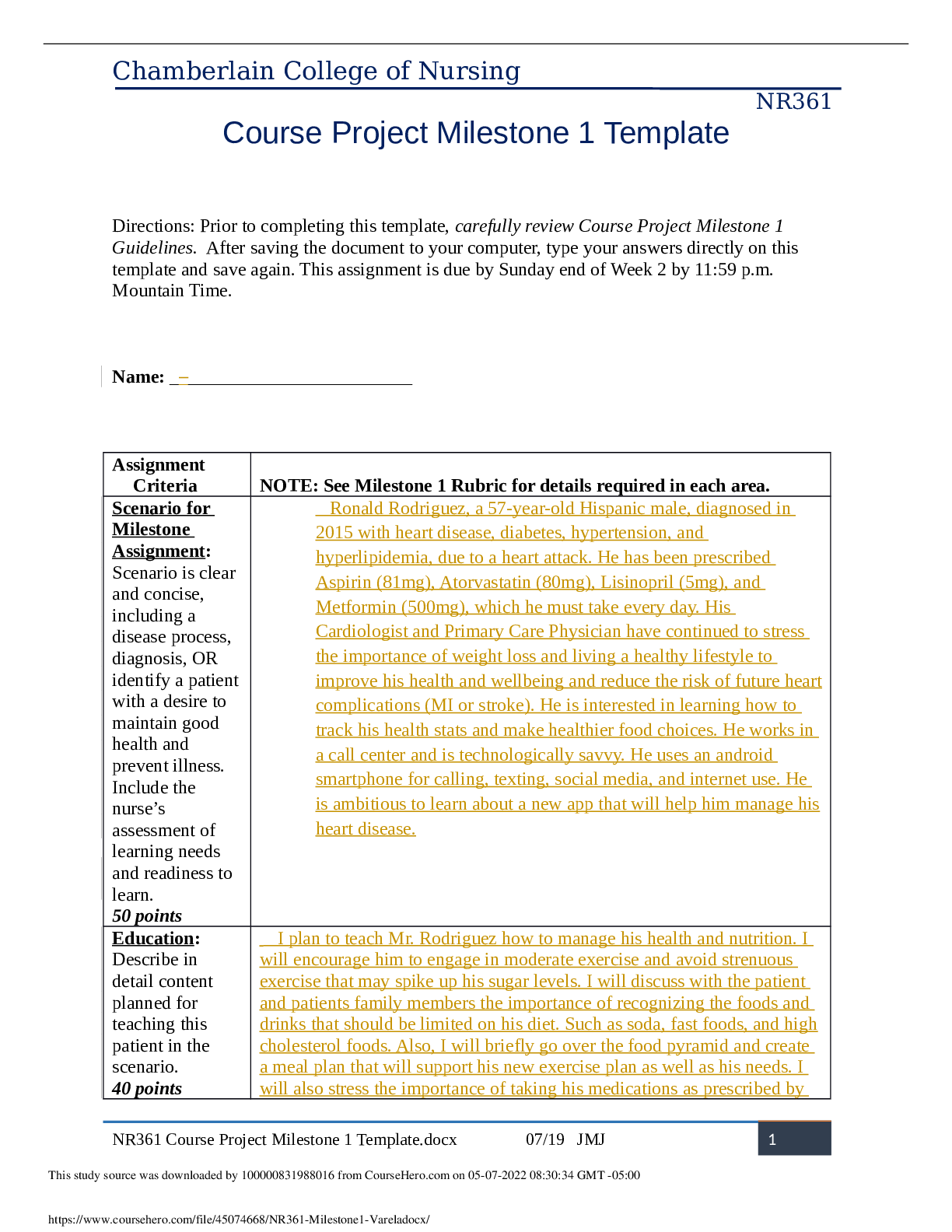
NR 361 Week 2 Course Project Milestone 1 (Ronald Rodrigues);Complete Solution
$ 9

Math 225N Statistics Week 4 Quiz__Already Graded A.
*NURSING > EXAM > Christine Jean-Baptiste_Module 5 Knowledge Check_2020 | NURS 6501 Knowledge Check _Student Response (All)
NURS 6501 Module 5 Knowledge Check {Christine Jean-Baptiste} NURS 6501 Christine Jean-Baptiste Knowledge Check: Module 5 Student Response Scenario 1: Gout A 52-year-old obese Caucasian ma ... le presents to the clinic with a 2-day history of fever, chills, and right great toe pain that has gotten worse. Patient states this is the first time that this has happened, and nothing has made it better and walking on his right foot makes it worse. He has tried acetaminophen, but it did not help. He took several ibuprofen tablets last night which did give him a bit of relief. Past medical history positive or hypertension treated with hydrochlorothiazide and kidney stones. Social history negative for tobacco use but admits to drinking “a fair amount of red wine” every week. General appearance: Ill appearing male who sits with his right foot elevated. Physical exam remarkable for a temp of 101.2, pulse 108, respirations 18 and BP 160/88. Right great toe (first metatarsal phalangeal [MTP]) noticeably swollen and red. Unable to palpate to assess range of motion due to extreme pain. CBC and Complete metabolic profile revealed WBC 14,000 mm3 and uric acid 8.9 mg/dl. The APRN diagnoses the patient with acute gout. 1 of 2 Questions: Describe the pathophysiology of gout. Gout is an inflammatory response to excessive quantities of uric acid in the blood and in other body fluids, including synovial fluid. Individuals with gout may have an accelerated rate of purine synthesis accompanied by an overproduction of uric acid. A deficiency of the enzyme HGPRT can lead to an increased production of uric acid. At the cellular level, purines are synthesized to purine nucleotides, which are used in the synthesis of nucleic acids, adenosine triphosphate, cAMP, and cGMP. Uric acid is a breakdown of product of purine nucleotides. 2 of 2 Questions: Explain why a patient with gout is more likely to develop renal calculi. Uric acid is mostly eliminated from the body through the renal system. Urate is filtered at the glomerulus and undergoes reabsorption and excretion within the proximal renal tubules. In primary gout, urate excretion by the kidneys is sluggish; due to a decrease in glomerular filtration of urate acid or acceleration in urate reabsorption leading to the development of renal calculi. Scenario 2: Lyme Disease Stan is a 45-year-old man who presents to the clinic complaining of intermittent fevers, joint pain, myalgias, and generalized fatigue. He noticed a rash several days ago that seemed to appear and disappear on different parts of his abdomen. He noticed the lesion below this morning and decided to come in for evaluation. He denies recent international travel and the only difference in his usual routine was clearing some underbrush from his back yard about a week ago. Past medical history non-contributory with exception of severe allergy to penicillin resulting in hives and difficulty breathing. Physical exam: Temp 101.1 ˚F, BP 128/72, pulse 102 and regular, respirations 18. Skin inspection revealed a 4-inch diameter bull’s eye type red rash over the left flank area. The APRN, based on history and physical exam, diagnoses the patient with Lyme Disease. She ordered appropriate labs to confirm diagnosis but felt it urgent to begin antibiotic therapy to prevent secondary complications. Question: What is Lyme disease and what patient factors may have increased his risk developing Lyme disease? Lyme disease is a multisystem inflammatory disease caused by the spirochete Borrelia burgdoferi transmitted by Ixodes tick bites and is the most frequently reported vector-borne illness. The risk factor that increased the risk of Lyme disease clearing underbrush from his backyard around a week ago. Working outdoors makes a person more at risk. The hallmark bull’s-eye rash commonly appears at the site of tick attachment. Scenario 3: Osteoporosis A 72-year-old female was walking her dog when the dog suddenly tried to chase a squirrel and pulled the woman down. She tried to break her fall by putting her hand out and she landed on her outstretched hand. She immediately felt severe pain in her right wrist and noticed her wrist looked deformed. Her neighbor saw the fall and brought the woman to the local Urgent Care Center for evaluation. Radiographs revealed a Colles' fracture (distal radius with dorsal displacement of fragments) as well as radiographic evidence of osteoporosis. A closed reduction of the fracture was successful, and she was placed in a posterior splint with ace bandage wrap and instructed to see an orthopedist for follow up. - - - - - [Show More]
Last updated: 3 years ago
Preview 1 out of 15 pages

Buy this document to get the full access instantly
Instant Download Access after purchase
Buy NowInstant download
We Accept:

Can't find what you want? Try our AI powered Search
Connected school, study & course
About the document
Uploaded On
Jun 23, 2021
Number of pages
15
Written in
All
This document has been written for:
Uploaded
Jun 23, 2021
Downloads
0
Views
157
Scholarfriends.com Online Platform by Browsegrades Inc. 651N South Broad St, Middletown DE. United States.
We're available through e-mail, Twitter, Facebook, and live chat.
FAQ
Questions? Leave a message!
Copyright © Scholarfriends · High quality services·